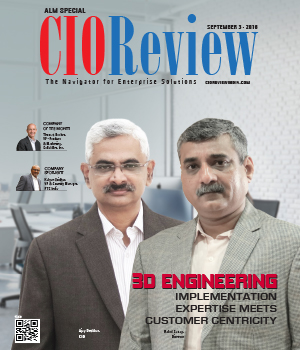
Application Lifecycle Management - Governance, Development and Operations
Krishnakumar Madhavan, Head IT, KLA-Tencor India | Friday, 16 September 2016, 10:27 IST
 Application lifecycle management (ALM) is the product lifecycle management of computer programs. It encompasses requirements management, software architecture, computer programming, software testing, Software maintenance, change management, continuous integration, project management and release management.
Application lifecycle management (ALM) is the product lifecycle management of computer programs. It encompasses requirements management, software architecture, computer programming, software testing, Software maintenance, change management, continuous integration, project management and release management.
The Three Aspects of ALM
Application Life Cycle Management can be divided into three distinct areas: Governance, Development and Operations.
An application’s life cycle begins with its creation, proceeds to deployment to production and ends in removal from service when the application no longer has business value.
Governance, which encompasses all of the decision making and project management for the application, extends over this entire time. The purpose of Governance is to make sure the application always provides what the business needs and to ensure an ongoing understanding of the application’s benefits and costs.
Development, the process of actually creating the application, happens between creation and deployment. For most applications, the Development process reappears several more times in the application’s lifetime, both for upgrades and for wholly new versions. Note that for some applications, the money spent on these updates and new versions can significantly exceed the original development costs. Modern software development can typically be thought of as a series of iterations. Each iteration contains some requirements definition, design, development, and testing.
Every deployed application must be monitored and managed. Operations, the work required to run and manage the application, typically begins shortly before deployment and runs continuously until the application is removed from service.
The three aspects of Application Lifecycle Management are tightly connected, and any organization that aspires to maximize the business value of custom software will have to do all three well.
ALM is much more than SDLC
Software Development Life Cycle – SDLC is limited to the phases of software development, i.e. requirements, design, coding, testing, configuration and project management. ALM deals with a broader perspective of applications. It does not finish at the end of development, but deals in removing when the application is no longer used by the business i.e. primarily many years after the initial development. To simplify, ALM is the superset which includes one or more SDLCs that may appear in the entire lifecycle.
As the three aspects of ALM – Governance, Development and Operations are the indispensable parts of any application, they need to be connected to each other to maximize business value of software. Having the right combination of tools and processes along with a streamlined workflow can make the job easier. There are a number of vendors and open source groups who provide tools to manage each of the ALM phases. Some vendors bring together a range of tools to support several aspects of ALM. However, ALM tools should be integrated not only horizontally, but also vertically so that connections can be established among cross-functional tools involved in the process, and therefore, the three distinct ALM phases can be performed well.
Any organization that wants to adapt to quickly changing requirements of customers and develop scalable and high-quality business applications on time, at lower cost, needs to set up an ALM framework around its teams and tools. One should take a broad and holistic view of ALM beyond SDLC steps, as that is mission critical to developing any business application.
Integrated Application Lifecycle Management (ALM) is a totally integrated set of tools and processes that help organizations manage the complete lifecycle of an application development. It connects different teams, activities, platforms, tools, and processes.
Organizations often spend millions in individual software development tools for managing Requirements, Projects, Portfolios, Software designs, Development, Testing, Deployment, Release and other functional areas. However, these tools are not connected to each other, and therefore, lead to cumbersome manual procedures while synchronizing data or processes between them. The situation worsens if teams working on those tools are geographically isolated and on different time zones. It is important that enterprises employ an integrated suite of tools that keeps team members in sync with each other. This ensures a greater degree of collaboration among cross-functional teams followed by better quality application and faster delivery.
Added value of using Integrated ALM:
• Overcomes challenges of globally distributed development - keeps all stakeholders synchronized
• Ensures seamless collaboration among ALM tools behind firewalls across diverse networks
• Manages projects and resources across the tools, breaking down organizational silos
• Helps monitoring exact status of different teams working on different areas of a project
• Maintains a centralized and single data repository for multiple ALM phases and artifacts
• Provides ALM tools interoperability, cross-repository linking and transparency across organizations
• Establishes end-to-end traceability of artifacts from within users’ preferred tool environment
• Automates lifecycle processes cutting across tool boundaries
• Reduces manual hand-offs between teams and tools mitigating chances of human error
• Saves time and cost in managing complex, multifarious projects
• Enforces best practice processes across best-of-breed tools. No compromise on tool selection and its operability
• Ensures code quality and performance throughout the lifecycle processes.
CIO Viewpoint
Automating Data Management and Business...
By Maurizio Canton, CTO, EMEA & Erich Gerber, General Manager, APJ, TIBCO
Digital Innovation on Rise Setting New Benchmarks
By Greg Morrison, SVP & CIO, Cox Enterprises
Application Lifecycle Management
By Judi Flournoy, CIO, Kelley Drye & Warren LLP
CXO Insights
The Rise of Developer-Led Innovation and...
By Subrato Bandhu, Regional Vice President, OutSystems
ALM to drive CIOs agenda for Competitiveness,...
By Kishor Chitale, CEO, Capgemini Local business services India & Middle East
Systematizing Knowledge for Better Outcomes







